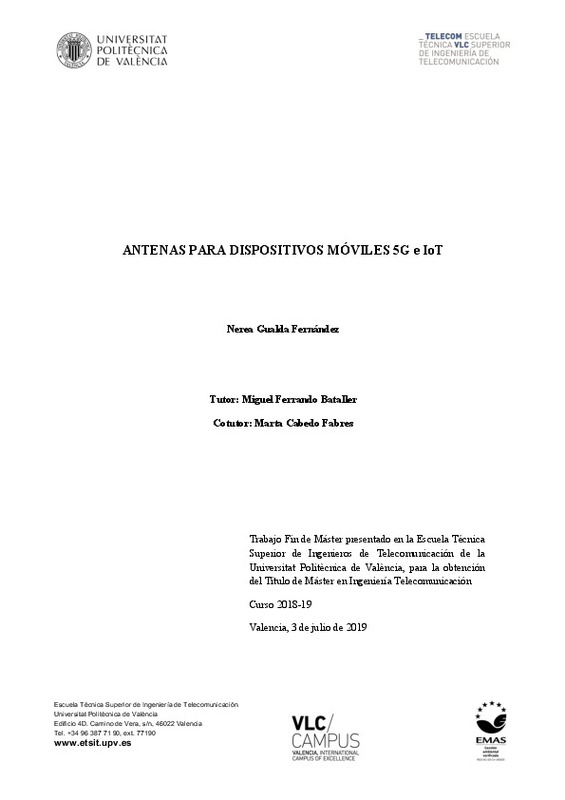|
Resumen:
|
[ES] La quinta generación (5G) de redes móviles de telecomunicaciones traerá consigo la implantación de los dispositivos pertinentes para su conectividad a la red, siendo para ello
necesario el diseño de antenas particularmente ...[+]
[ES] La quinta generación (5G) de redes móviles de telecomunicaciones traerá consigo la implantación de los dispositivos pertinentes para su conectividad a la red, siendo para ello
necesario el diseño de antenas particularmente adaptadas para los mismos. Las bandas de funcionamiento de estos dispositivos otorgadas para aplicaciones como Internet of Things serán las bandas bajas de 800 y 900 MHz, correspondientes a las bandas del Dividendo Digital en Europa, las bandas ISM otorgadas por la ITU, como es el caso de las bandas de 2.45 GHz y de 3.5 GHz, y, además, las bandas correspondientes a la propagación de ondas milimétricas.
El objetivo de este Trabajo Fin de Máster Antenas para dispositivos móviles 5G e IoT consiste en el diseño de antenas con buena adaptación, sintonizables y fáciles de implementar en placas de circuito impreso para su uso en dichas bandas de frecuencia. Serán antenas de bajo coste y altas prestaciones, es este caso, orientadas concretamente a su uso en las bandas inferiores destinadas a la próxima generación de telefonía móvil.
Gracias a un análisis exhaustivo de los dispositivos comerciales existentes a día de hoy, los cuáles poseen su funcionamiento en dichas bandas de frecuencia, se proponen diferentes
diseños de antenas con sus posteriores simulaciones con herramientas software de última generación. Además, de la construcción de prototipos para la comprobación de medidas reales con las obtenidas a partir de las simulaciones realizadas.
[-]
[EN] The fifth generation (5G) of mobile telecommunications networks will bring with it the implantation of the pertinent devices for their connectivity to the network, for this purpose
The design of specially adapted ...[+]
[EN] The fifth generation (5G) of mobile telecommunications networks will bring with it the implantation of the pertinent devices for their connectivity to the network, for this purpose
The design of specially adapted antennas is necessary. The operating bands of these devices granted for applications such as Internet of Things will be the low bands of 800 and 900 MHz, corresponding to the bands of the Digital Dividend in Europe, the ISM bands granted by the ITU, as is the case of the bands of 2.45 GHz and 3.5 GHz, and, in addition, the bands corresponding to the propagation of millimeter waves.
The objective of this Final Master Project "Antennas for 5G and IoT mobile devices" consists of the design of antennas with good adaptation, tunable and easy to implement in printed circuit boards for use in said frequency bands. They will be antennas of low cost and high benefits, in this case, specifically aimed at their use in the lower bands intended for the next generation of mobile telephony.
Thanks to an exhaustive analysis of the commercial devices existing today, which have their operation in these frequency bands, different antenna designs with their subsequent simulations with last generation software tools. In addition, the construction of prototypes for the verification of real measurements with those obtained from the simulations carried out.
[-]
|







